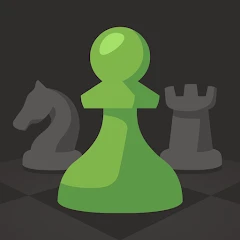How to Get Started with Chess - Play and Learn?
- 1. Learn the Rules
- - Understand the board setup, piece movement, and basic rules such as check, checkmate, and stalemate.
- 2. Familiarize with Pieces
- - Know how each piece moves:
- - Pawns: one square forward (two on first move), capture diagonally.
- - Rooks: move horizontally or vertically any distance.
- - Knights: move in an L-shape, jumping over other pieces.
- - Bishops: move diagonally any distance.
- - Queens: move in any direction any distance.
- - Kings: one square in any direction.
- 3. Learn Basic Strategies
- - Control the center of the board.
- - Develop your pieces (move them from their starting positions).
- - Protect your king (consider castling early).
- - Avoid unnecessary pawn moves and piece trades.
- 4. Play Practice Games
- - Use online platforms (like chess.com or Lichess.org) or apps to play against other players or AI.
- 5. Analyze Your Games
- - Review completed games to identify mistakes and missed opportunities.
- 6. Study Opening Principles
- - Focus on developing pieces, controlling the center, and ensuring king safety.
- 7. Learn Tactics
- - Practice common tactics such as forks, pins, skewers, and discovered attacks.
- 8. Explore Endgames
- - Understand basic endgame concepts and strategies, focusing on king and pawn endings.
- 9. Watch Tutorials and Read Books
- - Utilize online video tutorials or read beginner chess books to deepen your understanding.
- 10. Join a Local Club
- - Engage with other players for experience, tips, and support in learning.
- 11. Stay Consistent
- - Practice regularly to improve your skills and develop a deeper understanding of the game.
10 Pro Tips for Chess - Play and Learn Users
- 1. Control the center: Focus on controlling the central squares (e4, d4, e5, d5) to give your pieces more mobility and influence.
- 2. Develop your pieces: Prioritize moving your knights and bishops out from their starting positions to improve your board presence.
- 3. Protect your king: Castle early to safeguard your king and connect your rooks.
- 4. Think ahead: Anticipate your opponent's moves and consider their responses before making your own decision.
- 5. Avoid unnecessary pawn moves: Limit pawn movements unless they contribute to a strategic goal or improve piece placement.
- 6. Utilize tactics: Look for opportunities to use forks, pins, skewers, and other tactical motifs to gain an advantage.
- 7. Coordinate your pieces: Ensure your pieces work together and support each other in both offense and defense.
- 8. Pay attention to threats: Always be aware of potential threats to your pieces and position, and respond accordingly.
- 9. Learn from your games: Analyze your games afterward to identify mistakes and improve your decision-making for future matches.
- 10. Practice regularly: Consistent practice helps reinforce strategies and improve your overall understanding of the game.
The Best Hidden Features in Chess - Play and Learn
- 1. **Puzzle Rush**: A timed challenge where players solve as many tactical puzzles as possible within a set time limit, improving quick thinking and recognition of patterns.
- 2. **Analysis Board**: A tool to analyze specific positions, allowing players to explore various moves and lines without the pressure of an ongoing game.
- 3. **Opening Explorer**: A feature that helps players study and practice different openings by showing popular moves and statistics based on a vast database of games.
- 4. **Game Review**: An automatic feature that highlights mistakes, blunders, and best moves after a game, providing players with insights on their performance.
- 5. **Variants**: Play different chess variants such as Bughouse, Chess960, or King of the Hill, offering unique twists to traditional chess gameplay.
- 6. **Interactive Lessons**: Features lessons where moves are explained in real-time, allowing players to learn strategies as they practice against computer opponents.
- 7. **Game Transmission**: Follow live games from top tournaments and players, providing fans with the opportunity to learn from the best.
- 8. **Friend Challenges**: Ability to challenge friends to matches directly, fostering friendly competition and practice.
- 9. **Tournaments**: Participate in online tournaments, complete with rankings and prizes, creating a competitive environment for players at all levels.
Chess - Play and Learn Faqs
How can I start a new game?
To start a new game, open the app and select 'Play'. You can choose to play against the computer or a friend. Select your difficulty level and follow the prompts to begin the game.
What is the purpose of puzzles in the game?
Puzzles are designed to improve your chess skills by presenting specific scenarios you need to solve. They focus on tactical motifs, such as checkmates, forks, and pins, enhancing your strategic thinking.
How do I access tutorials and learning resources?
To access tutorials, go to the main menu and select 'Learn'. Here, you will find various lessons and interactive tutorials covering fundamental strategies, tactics, and advanced techniques to aid your chess improvement.
How can I analyze my games?
To analyze your games, go to 'History' and select the game you want to review. You'll see options for analysis, where you can see your moves, suggested improvements, and performance statistics to enhance your chess understanding.
What should I do to improve my chess skills quickly?
To improve quickly, focus on the following steps: 1. Practice regularly by playing games daily. 2. Solve chess puzzles to develop tactical skills. 3. Review your games with analysis tools. 4. Study openings and strategies to build your knowledge base.

1.Rate
2.Comment
3.Name
4.Email